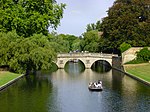Little Thetford is a small village in the civil parish of Thetford, 3 miles (5 km) south of Ely in Cambridgeshire, England, about 76 miles (122 km) by road from London. The village is built on a boulder clay island surrounded by flat fenland countryside, typical of settlements in this part of the East of England.
During the Mesolithic era, the fenland basin was mostly dry and forested, although subject to salt and fresh water incursions. The marshes and meres of this fenland may therefore have been difficult to occupy, other than seasonally, but there is evidence of human settlement on the island since the late Neolithic Age; a Bronze Age causeway linked the village with the nearby Barway, to the south-east. An investigation, prior to a 1995 development in the village, discovered a farm and large tile-kiln of Romano-British origin; further investigations uncovered an earlier settlement of the Pre-Roman Iron Age. The Roman road Akeman Street passed through the north-west corner of the parish, and the lost 7th century Anglo-Saxon village of Cratendune may be nearby.The 10th-century Old English name, lȳtel Thiutforda, suggests a ford across the nearby River Great Ouse, which today forms most of the village's eastern boundary. In 1007, an Anglo-Saxon noblewoman named Ælfwaru granted her lands in Cambridgeshire and Norfolk, including the "land at Thetford and the fisheries around those marshes", to the abbots of Ely Abbey; the village was still listed as a fishery in the Domesday Book, 79 years later. Pasture farming, and harvesting of reeds, peat, and rushes were the other dominant activities of the time. The draining of the land, which began in the 17th century, enabled arable farming activity that continues to this day. During the late 19th century, coprolite, a phosphate-rich fossil used as a fertiliser, was mined in shallow pits around the village.
Little Thetford resisted the Parliamentary Inclosure Acts of William IV for seven years, which may have led to the strong Baptist following amongst the poor of the village. About half of Little Thetford was eventually enclosed under the Parliamentary Inclosure Thetford Act of Victoria.
The river flooding, which affected 30 counties in England during March 1947, caused the Great Ouse to break its banks at Little Thetford. Heavy rain following a very severe winter overwhelmed multiple rivers throughout England and eastern Wales. It was the worst flooding in over two hundred years. The dismantled Ely and St Ives Railway crossed the A10 road at Thetford corner. The Cambridge station to Ely station section of the Fen Line passes through the east of the village. Occupying an area of 2 square miles (5 km2), and with a population of 792, Little Thetford is the smallest civil parish in the ward of Stretham; notable buildings in the village date from the 14th century.








